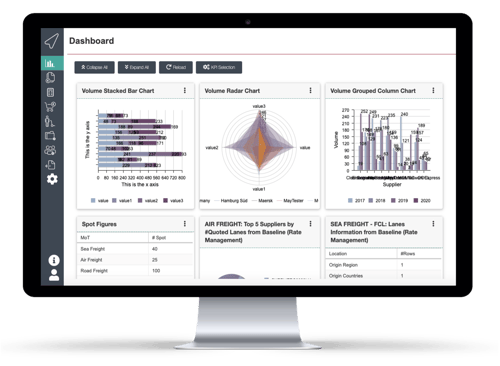Your own data is your best resource for improving your freight procurement strategy. It gives you the most accurate insights into which carriers offer you the best quotes and meet your business needs.
But all too often in logistics procurement, there’s so much data to track it feels impossible to analyse it and get a clear picture into what’s happening.
The good news is there are things you can do to get grips with your procurement data, learn from it and make smarter data-driven decisions.
Here are 4 ways you can get more from your own procurement data…
1. Store your data online
With so much freight procurement data still stored in Excel sheets, all too often this valuable data ends up saved in personal files and computers or worse - gets lost entirely.
Using an online cloud-based data storage solution, similar to Google Drive, means you never lose your historical rate data – and everyone in your team can access it and learn from it.
This will also save your team hours of time they would otherwise spend sending documents back and forward – time that really adds up!
Today’s logistic procurement tech makes storing all your data in one place in the cloud easy and secure. SHIPSTA lets you store and manage all your freight rates and contracts centrally in one place – this is linked to your data dashboard so you get a visual overview of all your data too.
2. Standardise your data structures
Analysing how your freight procurement changes year on year can help you build a data-driven strategy for the future. Too often though, rate sheets and historical data are too inconsistent to compare – so you can’t learn from them.
This is why keeping all your data standardised format that is comparable year on year will help you find insights into your own data.
Using a digital procurement platform makes standardisation of your freight data easy: after you’ve set up how you want it to look, all your future data will fall into this standardised template. So you never have to waste time cleaning up Excel sheets again.
3. Make your data visual
Looking at a spread sheet filled with numbers won’t give you a clear picture of your data – especially in the massive spreadsheets we use in freight procurement.
Creating graphs and data visualisations that take all that information and present it in a way anyone could understand at a glance is essential to learn from your data.
You don’t need to spend hours in creating graphs in Excel to achieve this. Today’s logistic procurement tech automatically creates easy-to-analyse reports that you can present to your team without any effort. Here's what our SHIPSTA data dashboard looks like...

4. Create your own benchmarking data
Benchmarking quotes against historical freight rates is one of the most effective ways to negotiate good shipping prices.
And while there are useful tools that can compare global historical data for shipping lanes, your own data historical procurement data will always give you the best data to benchmark against. This is more effective as your own data is more accurate to specific shipping needs – and therefore is better to benchmark against.
Do you want to learn more about how SHIPSTA can help you make the most of your own data? Book a demo and find out how our freight procurement software can help you make data-driven decisions and improve your logistics procurement strategy.
Subscribe to our blog to get more insights into freight procurement and logistics delivered straight to your inbox.
About SHIPSTA
SHIPSTA is a digital platform that connects shippers and carriers to ensure a frictionless procurement process for spot and contract buying, entirely online. It automates complex tasks, provides unrivalled visibility and supports fast data-driven decision making.
Designed and built by experts in logistics procurement, SHIPSTA is bringing transparency, automation and efficiency to the global logistics industry. It is used by some of the world’s largest companies to respond to market volatility, control freight costs and manage risk. The company was founded in 2015 and is based in Mertert, Luxembourg and Hamburg, Germany.



